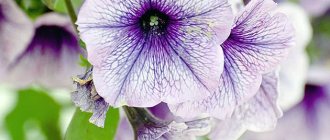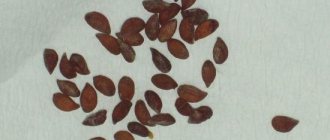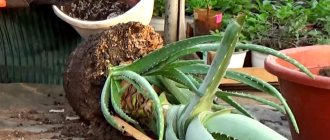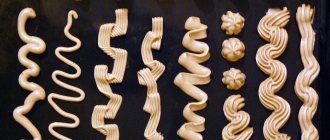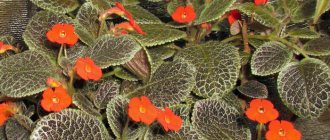Pineapple is a well-known tropical fruit that today is easy to find in the public domain and can be purchased at a relatively low price. But even better is to try growing it at home. To do this, you will need a ripe fruit with a healthy-looking top and a little patience.
It is generally accepted that pineapples need a special hot climate, which, of course, does not exist in the middle zone. However, in our latitudes they are successfully grown in greenhouses or indoor conditions. We will also focus on the second method of growing.
Pineapple grows well at temperatures of 22-25°C, but if it drops below 17°C, the plant will stop growing.
Conditions for germination
As already mentioned, for the successful growth and development of pineapple it is necessary to create conditions that are as similar as possible to natural ones. To do this, it is recommended to pay attention to several key indicators.
Lighting
It will require a lot of sun, so the pot with the sprouts should be located on the south side of the room. A pineapple needs 6 hours of sun per day, and in the cold season you will have to take care of additional artificial lighting: the lamps should be turned on for 8 hours every day.
In the summer months, you can take the container out to the balcony or transport it to the country house or place it in the garden. The pot does not need to be constantly rotated so that the sun illuminates parts of the bush evenly. It's easy enough to install in one place.
Temperature
The presence of drafts and low temperatures, dampness is death for the plant. Therefore, during the warm period, room temperature and that outside the home will be sufficient. But in winter you cannot lower the temperature below +18 - 20 degrees.
Humidity
The tropics require constant high levels of humidity. Therefore, place the tub with the plant in a container with wet sand or expanded clay. But it is undesirable to spray the above-ground part: rotting may begin.
The best place for good growth and maturation is a greenhouse or bathroom that has a window and daylight sunlight.
To prevent dust from accumulating on the surface of the leaves, they should be periodically wiped with a damp sponge.
Pineapple diseases and their treatment
It is more convenient to consider diseases and problems of pineapple in a summary form.
Table: main pineapple diseases, their causes and treatment
| Problem/Disease | Cause | Treatment |
| Infected by spider mites (if the air is dry), mealybugs, scale insects (brown plaques appear on leaves and stems), aphids, phylloxera | Treatment with a soap solution, washing with warm water and spraying with Actellik (1–2 ml per liter of water). | |
| Leaves are drying | The room is hot and lacks moisture | Watering and spraying on a regular basis. Transfer the plant to a cool place. |
| Pale leaf color | Lack of light | Changing the position of the pot: place it closer to a window or other light source |
| The tops of the leaves turn brown and dry out. | Lack of humidity | Spraying the plant and increasing the humidity in the room |
| Slow growing and does not bloom | Lack of nutrition | Plant nutrition |
| The lower leaves dry out, droop and curl | A sign of destructive drafts | Protecting the plant pot from drafts or changing its position |
| The socket is loose and falls apart | Lack of light | Changing the position of the pot: place it closer to a window or other light source |
How does an indoor pineapple differ from a cultivated one?
Before planting a pineapple at home, read the information about how a houseplant differs from a cultivated one. Indoor pineapples were developed as a result of selective breeding. This small compact plant with an exotic appearance is convenient to grow in a house or apartment. With proper care, the crop can bear fruit. A houseplant cannot boast of its species and varietal diversity.
Cultivated pineapples are grown primarily in Latin America. The plant has the appearance of a tough, thorny shrub with a herbaceous base. The lifespan of the crop consists of the period of forcing, flowering and fruit ripening. After the harvest is harvested, new plants will need to be planted to produce the next one.
The fruits of pineapple grown at home differ in external and taste characteristics from cultivated varieties. In domestic plants, the foliage is brighter and more variegated and has decorative properties. However, the taste and aroma of the fruits are poorer, weeks in plants grown in natural conditions.
How to get fruit to appear
It is impossible to predict the flowering of pineapple. This can happen two years after planting, or three or four. To achieve flowering and fruit development, the plant must be replanted every year in a larger pot and properly cared for.
Flowering begins with the appearance of a long stalk with an inflorescence at the top from the crown. For two weeks, one row of flowers blooms every day, starting from the bottom. They open only for a day, after which they wither.
After the last row withers, the fruit begins to develop. The process is long, depending on the type of pineapple it lasts 5-7 months. It can be considered ripe when it reaches a weight of at least 400-500 grams and the appearance of a strong sweet aroma.
Beginning of flowering
Blooming pineapple
Set fruit
Ripe pineapple
Some time after the fruit ripens, the mother plant dies, leaving many shoots that can be used for propagation. If the plant is at least two years old and is well developed, fruiting can be accelerated.
The flowering of bromeliads is stimulated by ethylene, which can be obtained in two ways:
- Ethylene is emitted by ripe apples, pears, bananas and other fruits. They can be placed in a pot with a plant and create a dome over it so that the secreted substance is concentrated around it.
Ripe apples are a natural supplier of ethylene
- An aqueous solution of ethylene is prepared by mixing calcium carbide with water. A teaspoon of powder is carefully poured into half a liter of water and kept covered for a day. Then the liquid without sediment is poured into a clean container. If you pour 50 ml of the resulting solution into the center of the leaf rosette every day for a month, the pineapple will bloom.
The substance is explosive when combined with water, so be careful
The absence of flowering after stimulation indicates that the plant is either not yet sufficiently developed or is affected by disease.
Agricultural technology for growing pineapple
The main steps for growing pineapple at home include the correct choice of soil, watering and fertilizing regimes, and caring for young shoots.
Priming
Pineapple loves light soil that allows moisture and air to pass through well. Ready-made mixtures can be purchased at gardening stores; soil for cacti or bromeliads is suitable. You can also prepare the ground yourself. To do this, you need to take in equal parts:
- peat,
- sand,
- turf land,
- leaf humus.
Heat the soil you prepared yourself in the oven for disinfection. When choosing a container for a sprout, give preference to a shallow, but rather a wide pot with a volume of 1.5–2 liters. Be sure to put drainage at the bottom.
The soil must be disinfected before planting pineapple in it.
Watering
Pineapple does not like excessive watering. In general, it is better to underfill it than to overfill it. In the natural environment, during droughts, pineapples can survive without water for up to 3 months. Watering depends on the time of year. In winter, plants freeze and practically do not grow. Water at this time of year once every 2-3 weeks. Before watering, check the soil in the pot; it should be almost dry. But as soon as the spring sun begins to warm up, the pineapple will actively begin to grow and more frequent watering will be required.
Transfer
It is recommended to replant pineapple once a year. Do not immediately transfer the plant from a small container to a large one. The volume of the pot is increased gradually. The root system of the pineapple is superficial, so replanting must be done very carefully, without damaging the roots. Having prepared a container with drainage, carefully, using the transfer method, transfer the plant along with the earthen lump to another pot.
Stimulation of flowering and fruiting
Pineapple needs nitrogen, so feed it every 2 weeks with mullein infusion or ready-made complex fertilizers. An adult plant can bear fruit for 3–4 years. However, pineapple, having gained good leaf mass, blooms reluctantly at home, so it is necessary to stimulate flowering. The first method is 1 tsp. dissolve carbide (used in gas welding) in 1 liter of water. Acetylene gas is released. After the reaction is completed, an aqueous solution will remain, 2 tbsp. l. which you pour into the middle of the outlet for a week. In about 30–40 days, a peduncle will begin to appear.
The second method is less effective, but easier to implement. Place a plastic bag over the plant and fumigate it with smoke from 2-3 cigarettes or smoking coals for 10 minutes. The operation is repeated up to three times, at intervals of a week. It is important that the bag tightly wraps the plant. Be sure to follow fire safety regulations.
The pineapple blooms for a month, after which the fruit sets. A ripe pineapple gives off a recognizable smell. If the fruit begins to exude a characteristic pineapple aroma, then after about 2–3 weeks the cone can be removed. The pineapple is ready to eat.
Reproduction methods
A pineapple plant that bears fruit gradually dies, but before that, 2–3 lateral shoots with their own root system (ratuns) are formed on it, as well as shoots that come out between the leaves and do not have their own root system (sakers). Plant cuttings only when the mother plant has completely died. During this time, the shoots can grow to half the height of the parent. Using a sharp knife, you need to carefully separate the shoot and plant it in a separate pot with a suitable soil mixture. So, from each plant you can get 3-5 new seedlings.
From each mother pineapple you can get 3–5 young seedlings
Video: caring for pineapple at home
Plant care
Rooting is only the first stage in solving our problem. It’s too early to calm down: you need to create conditions for the young plant and provide such care in which it will grow well and will eventually delight you with fruits.
Temperature and lighting
A tropical plant from the bromeliad genus, pineapple does not tolerate cold. It grows only in warmth and in good light, but the light should be diffused. The most comfortable temperature for him is from 22 to 26 degrees above zero.
In summer, the plant can be kept outside - on the balcony or in the garden, in the shade of trees. It responds very well to moving into fresh air. But the air temperature should not fall below 18 degrees.
Do not leave the young plant in the open sun
In winter, the place for the pineapple should be chosen so that it receives light for at least 6-8 hours a day, and the temperature remains at approximately the same level. South-facing windows are best suited for this.
Watering and spraying
The watering schedule depends on the season and growth phase.
- In winter, the plant is dormant and does not require frequent watering. It is enough to do this once a week.
- During the growth period, the frequency of watering is increased, avoiding stagnation of water. For this purpose, when planting, they provide good drainage.
You can spray the plant only in summer. In winter, excess moisture will accumulate in the leaves and they may rot.
Pineapple should be watered rarely, but abundantly.
For reference. Pineapple is quite well adapted to drought. Therefore, it tolerates a lack of watering more easily than an excess.
Top dressing
This plant does not need frequent feeding. In winter, it can generally be left alone by replanting it in soil with a high organic content. And in the summer, occasionally pamper with ready-made organic fertilizers or mullein solution, infusion of grass and eggshells.
Liquid organic fertilizer
Fertilizing can also be applied by spraying, but you need to make sure that the liquid does not get on the young leaves. Organic fertilizers are replaced with complex mineral fertilizers only during the pineapple flowering period.
Disease prevention and treatment
If you care for the fruit correctly, avoiding hypothermia and stagnation of water, the likelihood of it being affected by pests and diseases will be extremely low. If this does happen, the plant needs to be treated.
- insect pests (mealybugs or spider mites). Some time after treatment, they need to be washed with clean water. In complex and advanced cases, you will have to use insecticides.
Spraying with a soap solution can also be done for prevention
- Fungal diseases manifest themselves as rot. The central leaves begin to turn black and fall off first. The plant can only be saved with the help of fungicides, which are poured into the middle of the leaf rosette. But the old diseased shoot will have to be cut off after the new lateral shoot appears.
Diseased plant
Features of indoor pineapple
The only type of pineapple that can be grown at home in a pot is Ananas comosus. This is a fast-growing compact plant that reaches a height of about 1 m. The leaves of the plant are hard and form a funnel-shaped rosette. The formation of shoots begins after the infertility is fully formed. The flowering of the indoor plant begins in May. Decorative properties last until October-December. The flowers of the plant are light purple, very beautiful and unusual. After flowering, the fruits ripen within 4–5 months. The fruits gradually increase in mass and change. The pulp of the plant is edible, but in terms of taste it is inferior to pineapples grown in natural conditions.
How to grow pineapple at home
It's hard to find a person who doesn't like pineapples. But few people know that you can grow this extraordinary fruit yourself. Let's figure out how to do this.
From seeds
Sowing by seeds is probably the most difficult of all growing methods. Those fruits that are sold in stores are usually collected at the stage of technical ripeness and are completely unsuitable for this planting option. You need to purchase mature pineapple seeds. They are dark brown in color and 3–4 mm in size.
Only mature sprouted seeds are suitable for planting pineapple.
Carry out preliminary preparation of the material for planting.
- Place the seeds in a humid environment for about a day. This could be a sponge or a wet wipe.
- For planting, take peat and sand in equal quantities.
- Bury the swollen seeds into the soil mixture no more than 2 cm.
- Pour warm water over everything and create a greenhouse effect. Use film, plastic bag or glass. Now they sell ready-made mini-greenhouses - they are perfect for germinating pineapple seeds.
A ready-made greenhouse for growing pineapple seedlings can be purchased at a garden store
Place the container in a warm place: the most favorable temperature is considered to be from 22 °C to 30 °C. The higher it is, the faster the seeds will germinate. You can put the greenhouse on the battery by placing a board under it. At average room temperature, the first shoots will appear in about a month.
A pineapple sprout at the three-leaf stage can be transplanted from the mother into a separate pot
Monitor the soil moisture and feed the seedlings once every 3 weeks. The grown seedlings must be planted into separate pots so that each young shoot turns into an independent fruit-bearing plant. As the seedlings grow, it is necessary to increase the volume of the pot so that the development of the root system in young shoots does not slow down.
Interestingly, all cultivated pineapples do not contain seeds, but if they are crossed with wild forms, they regain the ability to form them.
foodnews-press.ru
https://foodnews-press.ru/zdorovoe-pitanie/45-topy-foodnews-press/1028-top-20-interesnih-faktov-ob-ananasah
From the top
In order to grow a pineapple from the top, you need to choose the right fruit. Winter fruits are not suitable for this, because during transportation the rosette of the plant often freezes. A fresh fruit with a dense, healthy top is suitable. The leaves should be green, not dried out or spoiled. Stepping back 2–3 cm from the leaves, cut off the top.
It is necessary to cut off the top for planting, 2-3 cm away from the leaves.
Here are step-by-step instructions on how to prepare a pineapple rosette for planting:
- If the pineapple is ripe, try carefully unscrewing the socket. All the juicy pulp needs to be peeled off, as well as the lower leaves.
- The cut is treated against spoilage with a manganese solution. You can dry the top for one or two days to prevent rotting.
- To accelerate the formation and development of roots, treat the cuttings with growth stimulants (Epin, Kornevin). To do this, dip the top cut side into the prepared solution for 12–18 hours.
- For further germination, place the tuft in water, securing it to the surface. If the container with water is quite narrow, then the plant will support itself, due to the leaf rosette. If the seedling falls through, secure it with toothpicks or a cardboard circle with a hole in the middle.
- After waiting for the roots to appear, the top is transplanted into specially prepared soil.
Video: how to germinate the top of a pineapple at home
https://youtube.com/watch?v=FVKwxHDDc8k


